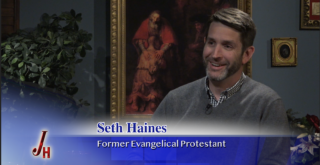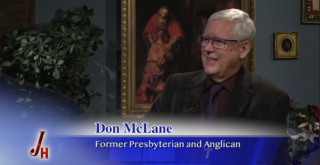
Conversion to Catholicism often involves tough choices and a transformation in a person’s thinking. This is nowhere more evident than in one’s thinking about the Church. Even many lifelong Catholics have difficulty thinking about the Church properly, much less thinking with the Church. One reason is that they have adopted many secular ideas from the culture around them.
Ongoing conversion or metanoia requires facing truth over and over again. Yet, facing truth is difficult; it requires an inner disposition of humility. Humility is not self-deprecation, much less ill will toward oneself. True humility has a spirit of acceptance of the reality that stands in front of us.
What is the reality of the Church that every convert must face? In the last installment, we saw that the Church is more than an institution dispensing sacraments; it is itself like a sacrament, an embodiment of God’s presence and life. This truth follows from Paul’s rich teaching on the Church as the Body of Christ in the New Testament and it is expanded in the Dogmatic Constitution on the Church of the Second Vatican Council (Lumen Gentium).
Since a sacrament makes the invisible grace of God visible and tangible, God’s own life is made accessible to human beings through concrete objects like bread and wine, water, oil, human voices and gestures. If the Church is like a sacrament, the Church must be visible too. If this is true, where is that Church which is the Body of Christ, that embodiment of God’s grace? What are the marks of the Church so that we recognize it when we see it? No one should ever doubt how heart wrenching this problem can be, especially for modern people. The problem of identifying the Church today is compounded by two modern facts: 1) the multiplicity of churches and 2) the doctrine of the “invisible church.”
The Church Invisible?
While the idea of an invisible church has always been implicit throughout church history — it lies implicit in Paul’s teaching and in the Church Fathers — the notion was developed with a new twist in the wake of the Protestant Reformation. One hundred and fifty years after the Reformation (ca. 1650), Europe could no longer be thought of as a Corpus Christianum. Now there were Lutheran, Reformed, Anglican, and Anabaptist churches, all claiming the name Christian and all having major conflicts of doctrine and practice among themselves. In the face of this startling diversity, some began to conceive of the church, not as identified with any one of them, but as consisting of true believers within all of them. The true church of Jesus Christ, so they said, was the body or collection of faithful Christians in churches with different creeds and different forms of worship (liturgy). The natural effect was to de-emphasize the visible church. Some went so far as to say that the visible forms of the church were manmade constructions or institutions. What really mattered to them was the body of believers scattered throughout the visible institutions. If the visible churches were man-made institutions, then it was an easy step for individuals to start their own churches with their own personally formulated creeds. These people assumed without argument that the Bible authorized them to start new churches with no connection to anything preceding them. Drive down the street of almost any town in the United States and the evidence for this belief is all too evident. This “sufficiency of the invisible church” doctrine is an assumption that few ever question and which has led to the proliferation of multiple creeds, divergent moral positions, and forms of worship.
Not all forms of Protestantism equally embrace this invisible church idea. Two of the most influential Protestant theologies differed radically on this issue: the Lutheran and the Reformed. By and large, Lutheranism did and still does reject “the sufficiency of the invisible church” doctrine while the Reformed embraced it in a moderate form. Yet, it might not be an exaggeration to say that Calvinism (Reformed) was the most influential theology brought to the American colonies.
The Church Mystical
Today, there are two broad institutional bodies which reject “the sufficiency of the invisible church” doctrine: the Orthodox churches and those churches in communion with Rome (e.g. Roman or Latin, Byzantine, Maronite). While strongly affirming the invisible or mystical realities within the visible church, they also insist that the visible and the invisible cannot be separated or alienated. They are two aspects of one sacramental reality. Within the western (Roman) Catholic Church, there have been varying emphases at times. The greater emphasis has fallen on the visible with the last five hundred years, probably as a response to the Protestant tendency to emphasize the invisible church.
In the one hundred years or so prior to the Second Vatican Council, an awareness grew within Catholic circles of the need to return to the invisible, or better, the mystical dimension of the Church. Numerous articles and books on the mystical nature of the Church appeared in the first half of the twentieth century, culminating in the encyclical Mystici Corporis Christi of Pius XII (1943). This encyclical is a treasure trove of good spirituality and theology of the Church.
The Lineaments of the New Testament Teaching
When questions and doubts abound, it is crucial that the conscientious Christian return to the sources of his faith and that means returning to the New Testament for a fresh look. A survey of different theologies of the Church (ecclesiology) shows clearly that the Catholic view differs fundamentally from other views common in western Christianity. The Catholic view involves at least five claims:
1) Jesus Christ established one Church, not many
(the uniqueness claim).
2) The one Church of Christ must teach true doctrine of Christ Himself and His official representatives, the Apostles (the veridical claim).
3) God intended the Church to be populated with a wide diversity of peoples who bring distinctive gifts and ministries to the one Church (the diversity claim).
4) All diversity within the Church serves the greater purpose of unity (the centripedal claim).
5) The deepest and most pervasive law of the Church must be the law of love (the animating claim).
It is impossible to provide the basis of these claims in the short compass of this article but everyone must understand these five if his conversion is to be real and lasting. The first claim (uniqueness) says that there is ultimately only one Church on the earth and that it was established by Jesus Christ Himself. Matthew 16:18 has always been taken as the foundation of this belief, “I will build my Church and the gates of hell will not prevail against it.” Jesus, of course, spoke in the singular (church, not churches) but He also asserted that this Church is indefectible. It will never vanish from the earth nor be eradicated by demonic influence.
The Acts of the Apostles records the ministries of Peter and especially of Paul in founding churches throughout the Roman Empire. But the whole narrative of Acts attests that the churches scattered throughout the Empire were considered one Church. This is what makes sense of the Jerusalem council where “the apostles and the presbyters” met to determine what was necessary for the whole Church (Acts 15). The Ecumenical Councils of the ancient Church (e.g., Nicaea, Chalcedon) are further proof of the belief that the various churches strung throughout the world must be unified in doctrine. Ancient Christians embraced an idea which many modern Christians may find hard to accept. They accepted as unproblematic the idea that there is only one Church and that this Church should always be unified in the Faith.
Passages like 1 Corinthians 1:10-17 and Ephesians 4:13 show that unity of doctrine or teaching is essential to the Church. Extended passages such as 1 Corinthians 12:1-30 show that God intended the Church to be populated with a diversity of people, ministries, and gifts but also that those diverse expressions of service were all intended to serve a greater unity of doctrine and love. In other words, the force of the Spirit’s work is centripedal, not centrifugal. The work of the Holy Spirit pulls all toward unity.
The only power sufficient for building a universal yet unified Church is the presence of the Holy Spirit, called by many Church Fathers “the soul of the Church.” As the soul and body can only be separated except by death, so the Holy Spirit cannot be separated from the Body of Christ (the Church) except by the dissolution of the Church. And that is what Christ promised would not happen. It is the supreme law of love that Christ commanded for the Church and which the Holy Spirit infuses into the hearts of believers (see Rom 5:5). On a human level, it is the Christ-like love of the Spirit that allows the Church to be one and to present a unified witness to the world.
The Problem of the One and the Many
Ancient philosophers posed a perplexing problem that is still with us today, the problem of the One and the Many. Christians have their own problem of the One and the Many as well. Amid the dazzling varieties of the Christian Faith, Christians often fall into one of two unhappy solutions. The first is to insist that their own church is the true one while all others are false, opting for unity without any diversity. Some see the Catholic Church in this category but this is not really accurate. The underlying question is how we know which church has a rightful claim to be the original Church that Christ founded. The opposite approach is to affirm diversity without little or no unity. Different creeds, different forms of worship, and divergent positions on moral issues are all accepted as legitimate forms of the Christian Faith. Yet, both these solutions carry with them innumerable problems.
A Christian in the twenty-first century who takes his faith and the Bible seriously is faced with a daunting challenge. The Bible teaches rather clearly that every baptized disciple of Jesus Christ is a member of the Church, but the modern Christian may have a formidable problem in knowing which church is the one Jesus established. Should he consider all churches the same, as legitimate expressions of Jesus’ desire? Or is there one or a few churches which have a greater claim to Jesus’ words? Every convert to Christ must eventually face this question.
Part Two: From Private Judgment to Universal Consent
Part Three: A Sacramental Worldview










